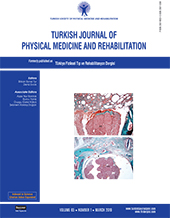Translation, reliability, and validity of the Turkish version of the Neck Bournemouth Questionnaire
2 Department of Statistic, Yıldırım Beyazıt University, Ankara, Turkey DOI : 10.5606/tftrd.2019.2693 Objectives: The aim of this study was to translate the Neck Bournemouth Questionnaire into Turkish and to test the reliability and validity of the Turkish version of the Neck Bournemouth Questionnaire (BQc-t).
Patients and methods: Between June 2014 and July 2015, a total of 97 patients with neck pain (27 males, 70 females; mean age 46.6±10.6 years; range, 18 to 65 years) were included in the study. The patients underwent a physical therapy and rehabilitation program. For translation, the American Association of Orthopedic Surgeons guideline was used. The reliability was measured with internal consistency and test-retest by calculation of the Cronbach alpha and intraclass correlation coefficient (ICC) respectively. Internal construct validity of the BQc-t was analyzed with confirmatory factor analysis. For external construct validity, the correlations between the BQc-t results and the Neck Pain and Disability Scale (NPAD), Modified Neck Disability Index (MNDI), and Short Form-36 (SF-36) were analyzed before and after treatment. Responsiveness was calculated as the effect size (ES) and standardized response mean (SRM). Minimal detectable change (MDC) score was calculated to evaluate interpretability.
Results: The ICC value for test-retest of total score was 0.945. Pre- and post-treatment Cronbach alpha coefficients were 0.877 and 0.907, respectively, showing that the reliability of the BQc-t was considerably high. Confirmatory factor analysis showed that questions were found to cluster in a single dimension. In terms of the external construct validity, there was a positive statistically significant correlation between the BQc-t questions, except for Question 7, and relevant subscales of the NPAD and MNDI. There was also a negative statistically significant correlation between the BQc-t questions and SF-36 subgroups. The ES and SRM were 1.23 and 1.48, respectively. The MDC was 20.31.
Conclusion: Our study results show that the BQc-t is reliable, valid, and sensitive to clinical changes.
Keywords : Neck Bournemouth Questionnaire, neck pain, questionnaire, reliability, translation, validity

















